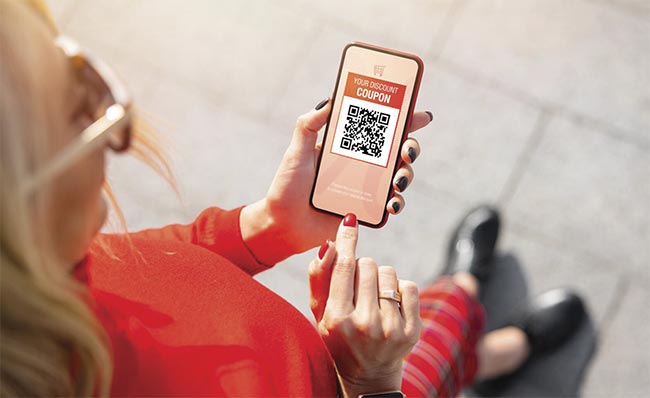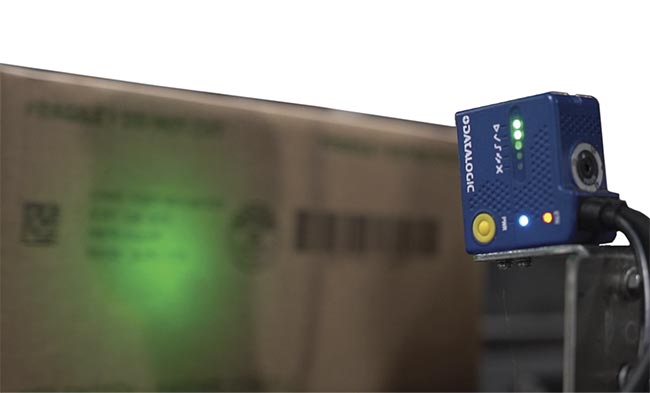The original swept-beam laser scanners have been supplanted over time by machine vision-based area-scan readers.
HANK HOGAN, CONTRIBUTING EDITOR
An audible beep often
indicates a successful
barcode scan. Such scans are performed 6 billion times a day, according to the global supply chain barcode standards company GS1 US. Barcode scanners are part of a multibillion dollar market that is expanding at a 7.6% compound annual growth rate, according a 2020 report from Coherent Market Insights. Analysts predict that the market value for barcode scanning hardware, software, and services will reach $10.8 billion by 2027. Machine vision-based mobile scanners in health care, retail and commercial settings, manufacturing, and warehouses will spur much of this growth. Innovations are needed, though, to increase mobile barcode readers’ performance, reduce their size, and cut their cost.

Barcodes, once confined to printed labels, are now found on screens, requiring advancements in scanning technology. Courtesy of ScanSource.
Reasons for the growth in barcode scanning include new applications and changes in the way people shop — shifts due in part to pandemic-accelerated trends.
“What’s suddenly getting interest is ‘buy online, pick up in store,’ as well as curbside interactions with retail customers,” said Kyle DeWitt, vice president of technical services at ScanSource, a global technology products and solutions provider. “The use cases are dramatically different than they were in the past.”
Swept beams
First demonstrated in 1974, barcode scanning technology originally used lasers. Mechanical methods swept beams of intense light across a series of dark lines and white spaces, with a sensor capturing the reflected return. Software then decoded this information into a unique identifier, making it possible to tally items automatically and quickly during grocery checkout or at other locations along the supply chain.
This original technology worked in many applications but presented problems in a mobile setting, said Dan Hare, senior vice president of business development at Apis Wise, an automation technology company. Apis Wise uses both fixed and mobile laser-based line-scan barcode readers and camera- or machine vision-based area-scan barcode readers for industrial applications, such as tracking items as they move through a warehouse or a factory.
Knocked out of alignment
One drawback of the laser-based approach is that moving parts are involved, which increases the amount of maintenance needed. Also, users sometimes drop mobile barcode readers, with high occurrences in factories
or anywhere gloves are worn. A traditional laser scanner that hits a hard floor can be knocked out of alignment, receive damage to its mechanical systems, or be put out of commission altogether.

Mobile barcode readers offer retailers the capability to expand their customer service, enabling flexibility when business conditions change. Courtesy of ScanSource.
Additionally, a laser-based scanner needs to be positioned in a specific orientation to successfully read a barcode, and often the only kind of barcode that this scanner can read is a one-dimensional string of lines and spaces. Thus, the technology cannot handle a 2D barcode, which uses dots and other symbols or shapes in a square or rectangular format. A further drawback is that a laser system cannot scan a smartphone because the screen only minimally reflects light.
Barcode readers today are no longer used just to track products as they move along a supply chain. They now also form part of the customer interaction system and are a key part of retail, inventory management, and other processes.
“In the mobile space, everybody has moved away from laser scanning and moved toward vision,” Hare said. He added that a vision-based approach also offers more flexibility.
But the transition from laser to vision was slow to get underway, he said, in part because of the poor performance of the early vision solutions. In most machine vision settings, lighting is important, often critical. Barcode scanning is no different. The difficulty is that in a mobile application, the lighting is variable, as is the contrast between the items of interest and the surrounding areas. Barcodes also come in a variety of sizes, shapes, and specifications, which can make it difficult for an automated system to figure out what elements in an image constitute a barcode.

Although barcodes started as a way to track inventory, they are now used for many purposes, such as providing coupons and other customer perks or services. Courtesy of ScanSource.
In addition to these challenges, a mobile scanner often has to fit a barcode reader, a processor, wireless communication, and more into a form factor that is easy to hold and use.
The scanning software must also be easy to use, even for a novice after training.
To meet these requirements, mobile barcode readers use various vision-related technologies. For instance, some devices from Datalogic, a leading provider of barcode scanners, use a liquid lens, which enables a change in the system’s focal characteristics so that standard, wide-
angle, or high-density codes can be scanned. Aiming involves projecting a red laser diode dot onto the barcode so that the user can be sure the barcode is in the device’s field of view. During scanning, white LEDs illuminate the area of
interest. A sensor captures the image (sometimes with >1-MP resolution).
Software then interprets the image and transforms it into information that is then passed along to the next step in the process. The processor and all the other device hardware, including the battery, weigh less than a pound.

A barcode scanner reads serialized cases for pallet aggregation. Barcode readers are increasingly used in the warehouse and for logistics, along with in retail and other applications. Courtesy of Apis Wise.
Reading range, according to Datalogic product datasheets, can extend from surface contact to over 1-m separation, if conditions allow. The maximum distance is a function of barcode resolution. The minimum depends on the length of the barcode and scan angle, since all of the symbols must be imaged. Other important factors are the printing resolution, the contrast of the print with the background, and the ambient light.
Pinning down precise values for operating-range parameters is difficult — in part because users change the distance or angle of the hand-held mobile reader to the barcode as needed in order to achieve success.
“It’s operator adjustment on the fly,” Hare said. “Get into a darker environment, you get closer to the object. Because these products are so widely used, and used so often, users are starting to make adjustments in situations where the scanners otherwise don’t really work that well.”
In the future, Hare said users will likely be able to scan at greater distances while working with smaller codes. Users also want to be able to scan at higher speeds and in a wider range of lighting while using smaller devices, he said.
Sensors, optics, and other photonic technology advancements can help to meet these goals. Sensor innovations, for instance, can lead to more compact scanning engines. Sensors that can produce higher-quality images can help to speed up scan times. Hardware advancements in the sensor and other components can also extend battery life.
Power consumption, though, is often driven by software. Thus, Hare said, while hardware innovations may help batteries to last longer on a charge, the biggest benefit may come from software improvements, such as the implementation of more efficient image processing and decoding algorithms.
Cost is king
According to analysts, a key barrier to the wider use of mobile barcode scanner solutions is cost. Some of the expense of the mobile scanner is
attributable to the hardware and some to the software in the device or on
the backend servers, where data is aggregated and analyzed. As device volumes go up, costs should come down, which would help to further spur the adoption of mobile barcode reader technology.
Hare said attempts have been made to use general-purpose consumer-grade smartphones as industrial-grade mobile barcode scanners. These
efforts have not been successful so
far because of the mismatch between
consumer technology and industrial needs.
“You’re taking a knife to a gun fight,” he said.
Consumer smartphones, for example, are not rated to withstand multiple drops onto concrete floors or other hard surfaces. Another problem is that operating or even holding a smartphone with gloves is difficult. Industrial settings also often require equipment to have an IP65 rating, which indicates a level of protection against dust and water that consumer products typically lack.
Despite these obstacles, ScanSource’s DeWitt said, something akin to an industrial version of “one device to rule all applications” is coming. Barcode readers today are no longer used just to track products as they move along a supply chain. They now also form part of the customer interaction system and are a key part of retail, inventory management, and other processes.
The latest solutions being explored focus on integrating multiple technologies — such as scanner, printer, cash drawer, and signage — in a retail setting. In the future, much of this may be performed on a descendant of today’s mobile barcode reader.
DeWitt said the real growth opportunity may lie in integrated mobile computing devices with built-in barcode scanners.
“Long live the all-in-one compute, scan, image, and app device,” he said. “Think apps being developed that manage loyalty programs, coupons, inventory management, and returns, among others. They are going to be the hot commodity.”